(succulent soil for indoors,Best succulents for indoors, Best indoor succulents low light, Succulent plants indoor benefits)
Succulents are popular as indoor plants.A growing number of succulents, once considered outdoor plants for hot climates, can now be found at home thanks to their love of dry, warm climates and their unpretentiousness. If you want to create your own miniature indoor garden, which also does not require much care, then these five plants are for you.
1. Aloe vera
( Aloe vera )
Aloe officinalis can have a dual function in the home, both as an easy-to-care indoor plant and as a treatment for inflammation and burns, especially sunburn.
It has tough, erect leaves that grow in lumpy rosettes. Look for hybrids that will remain small creating miniature compositions.
Care
Plant in well-drained soil and place in an area that receives bright indirect light. A south facing window is ideal, but they also work well for east or west facing windows. Best of all, aloe plants feel indoors at temperatures from 12.8 to 26.7 ° C.
Water the aloe medicinal plant about every three weeks or when the soil dries to a depth of 2 to 3 cm and let the water drain completely; the plant should never sit in water. Water less in winter. Feed a balanced fertilizer at half strength every month in the spring and summer to stimulate growth.
Caution: Aloe is a great topical lotion, but should not be eaten by people or pets.
2. Morgan's sedum (Donkey's tail)
(Sedum morganianum) The
Morgan's sedum, also called donkey's tail, was created for growing in hanging containers. The stems are lined with densely thick gray-green leaves that can reach 60 cm in length, giving the plant its generic name. Use it as a stand alone plant or let it hang over the edge of a hanging container.
Because donkey tail leaves store water, choose a sturdy container and hang it sec
Care
Choose well-draining soil that is neutral to slightly acidic and place the container in a location where it will receive at least four to six hours of bright light, such as a sunny window facing south or west. The plant thrives best at 18.3 to 23.9 ° C in summer and 12.8 ° C in winter. You can also provide slightly less light during the winter months.
Let the soil dry between waterings, then water thoroughly and let the water drain completely. Reduce watering a bit in winter. Feed monthly in the spring and summer with a balanced half strength fertilizer.
The stems of the plant break off easily, so keep the plant in a safe place to avoid accidentally hitting it.
3. Young or tenacious
(Sempervivum spp.)
It is not surprising that the tenacious turned from frost-hardy street succulents into juicy indoor stars. They thrive in high temperatures and lower humidity levels in most homes, and you can easily mix them in a container garden with other succulents, or display them yourself.
With a growing number of hybrids, in addition to the familiar species, you can now find juveniles in a wide range of colors, from reds and burgundy to greenish yellows, blues and purples.
Grooming
Give these highland natives well-draining soil and at least six hours of bright direct sunlight. Their color may fade in less light. They thrive best in temperatures between 18.3 ° C and 23.9 ° C during the day, and can tolerate very cold temperatures at night.
Water in moderation, let the water drain completely, and let the soil dry out between waterings (water again if the plant shows signs of shrivelling). Feed with a balanced, quarter strength, water-soluble fertilizer four times in the spring and summer.
The mother plant will die off in four to six years, but you can easily transplant the babies as soon as they appear to grow new plants.
4. Crassula or money tree
(Crassula ovata)
You can bring the money tree into your home as a small houseplant, but under the right conditions you will end up with a striking tree-like houseplant about a meter high with shiny plump green leaves and a thick, sturdy trunk and stems. This data, along with ease of care, is why Crassula remains a popular choice for indoor plants.
Grooming
Choose a pot that is wide and sturdy as the branches of these plants make them heavy. Use a well-draining potting soil mixture and place in an area with at least four hours of sunlight; the south facing window is ideal. Crassulae with variegated leaves will need more light. Protect from drafts and cold windows in winter. They grow best at 18.3 to 23.9 ° C in summer and 10 to 12.8 ° C in winter.
Water thoroughly about once or twice a month when the topsoil is dry to the touch, making sure the water drains well and the plant does not sit in the water. Cut back on watering in winter. Wrinkled leaves indicate insufficient watering.
Feed a balanced half-strength water-soluble fertilizer every two months, adding it when the soil is wet to stimulate growth, although you can get away with less. Wipe the leaves with water and a soft cloth to keep dust out.
5. Haworthia striped or zebra
(Haworthiopsis fasciata)
The plant cannot be large, as a rule it only reaches about 15cm in height. Its hard, triangular leaves 3 to 4cm long, which grow vertically from the center of the plant, are smooth and green on the inside and adorned with prominent white teeth on the outside, giving this succulent its common name. The zebra's small size and tolerance to lower indoor humidity levels have led to its popularity as a houseplant.
Leaving
Plant the Hawortia in well-drained soil and place in a location that receives bright sunlight most of the day, such as facing south or east. A little more sunlight will give the leaves a pleasant orange-red hue. If the plant gets too much sun, the leaves will turn white or yellow. It is worth maintaining a normal room temperature from 18.3 to 26.7 ° C.
Water when the soil dries out from spring to fall, being careful not to get the leaves wet. In winter, cut and water when the leaves begin to appear wilted. Feed with a diluted balanced liquid fertilizer once a month from spring to fall.
5. Eonium
The leaves of aeonium, rounded and slightly pointed to the tips, resemble multilayered dahlia or rose flowers in appearance. At the same time, they have completely unique colors - a green gradient along the jagged edges can be edged with pink or red, there are also dark purple, black, lemon, creamy green species. The stem of the indoor aeonium is very short, and the leaves are tightly pressed against each other, growing in a checkerboard pattern from the center to the edges.
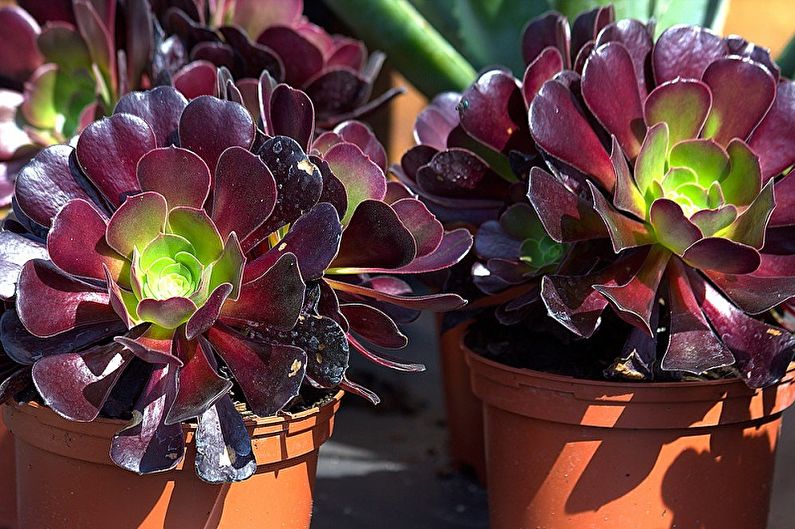
6. Graptopetalum
The attractiveness of this plant lies mainly in its unusual flowering. Around May-July, twigs with beautiful pink five-petal "stars" appear from a squat rosette of fleshy leaves. In the center of the opened buds, bright yellow stamens on long legs sparkle, which give the blossoming flowers a special festive charm. This extravaganza lasts 2-3 weeks, and then the succulent returns to its standard appearance for fat women.
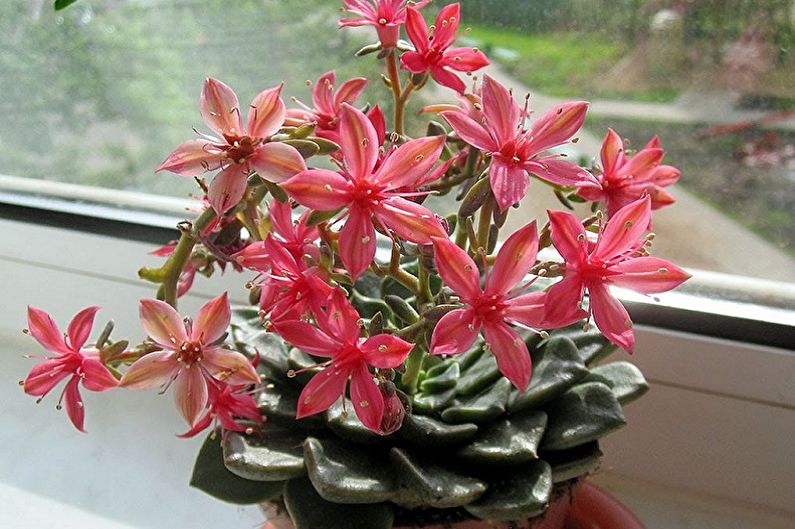
7. Pachyphytum
The Greek name Pachyphytum means "thick-leaved", which really can be considered the main feature of this succulent. Its dense leaves in the form of elongated and slightly flattened grapes are covered with a bluish waxy coating, which prevents moisture evaporation. The plant has the form of numerous pineal processes, which are interconnected by short, stiff stems. The pachyphytum blooms inconspicuously, releasing small pinkish shoots like slightly deformed ears.
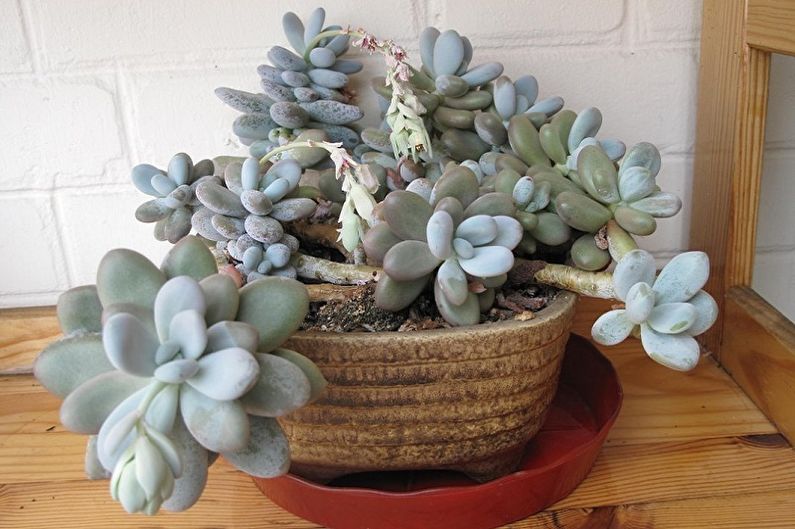
8. Aichrizon
This succulent is also called the "tree of love". With its small dark green leaves, crown-shaped branches and dense stem, it really resembles a miniature tree. The associations with romance are probably due to the heart-shaped shape of the leaf blades. In the spring-summer period, aichrizon is covered with a lush cloud of small golden flowers, which are very similar to the panicles of St. John's wort. To form the crown, the tree is regularly pruned, and in the warm season it needs regular watering with small doses of water.
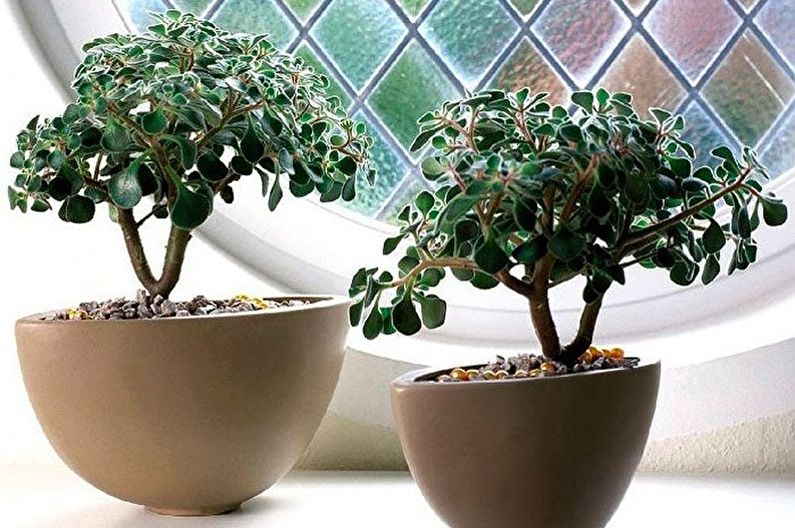
9. Monantes
A large number of small green bumps growing directly from the ground - this is Monantes. During flowering, a thin reddish stalk with a pale yellow "star" at the end rises from the center of each rosette. This succulent is valuable for its diminutiveness, and in compositions it makes an interesting background for larger plants.
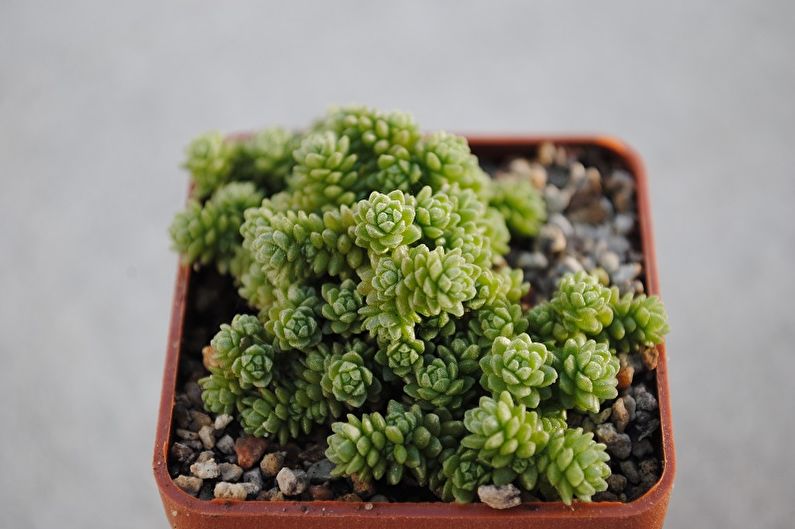
10 . Fat woman
Much more often this plant is referred to under the names "crassula", "tree of happiness" or "money tree". Its rounded leaves with a yellowish sheen look like coins, so this succulent is considered an amulet that attracts financial wealth and prosperity to the house.
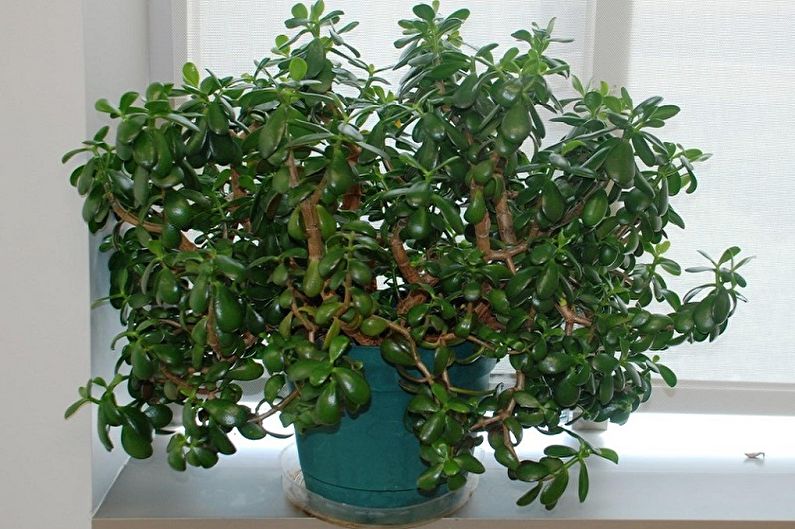
11 . Brigamy
A bright palm-like plant known under the names "Hawaiian palm", "volcano palm". In autumn, yellow star-shaped flowers appear at the green top, with which the succulent takes on an even more exotic look.
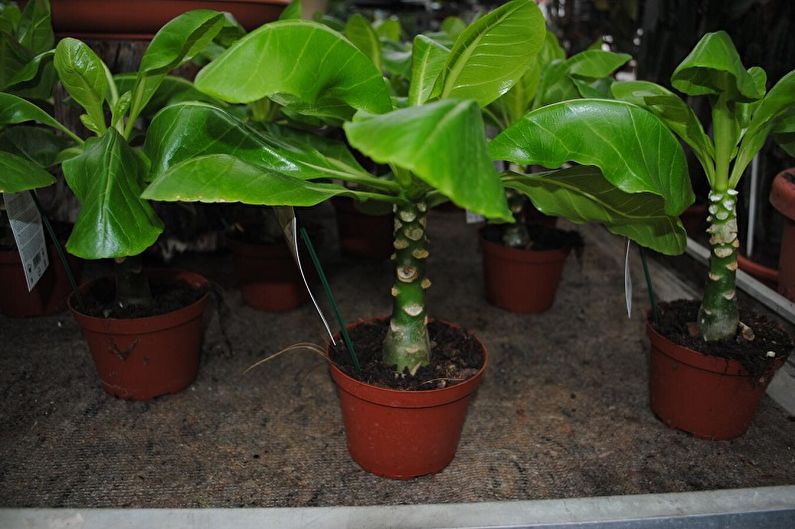
12. Portulacaria
, or "elephant bush", is an ornamental mini-tree with a very powerful dark brown tree-like stem. In texture, it really evokes associations with the legs of elephants, but countless miniature light green leaves against the background of a thick base look very contrasting.
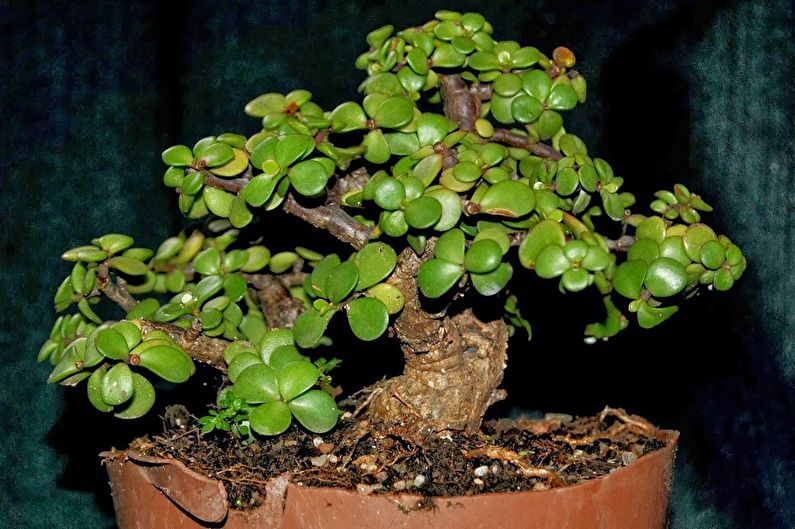
13 . Argyroderma
which in translation sounds like "silver skin", owes its name to a unique color. The cold greenish tone of the dense leaves, due to the light gray waxy coating, seems even more mysterious. In shape, this plant repeats sea stones - the same smooth and oval-flattened, but dissected in the center. During the flowering period, the flaps open slightly, and in each there is an incredible beauty "aster" of orange, pink or bright yellow color.
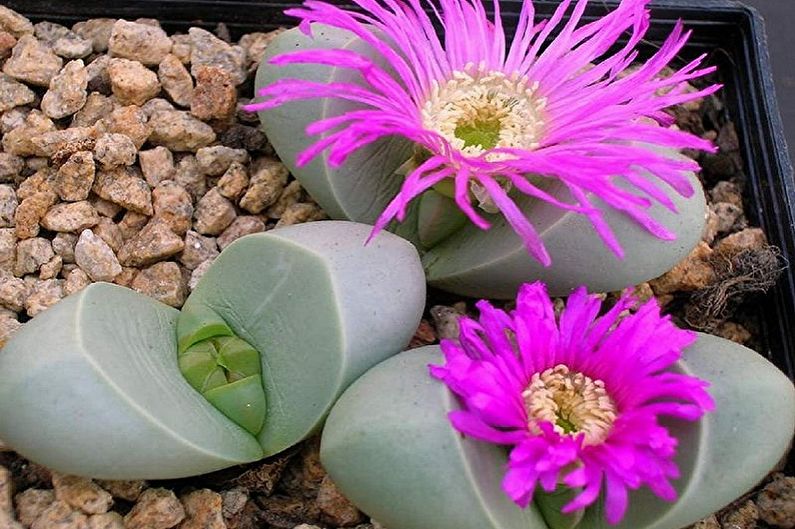
14 . Lithops , or living stones,
cannot be immediately distinguished from pebbles. The gray, slightly mottled color completely disguises them in the natural environment. The succulent gives out belonging to the plant kingdom only during flowering, when bright "daisies" in yellow, orange, pink or white tones bloom among the rounded half-leaves.
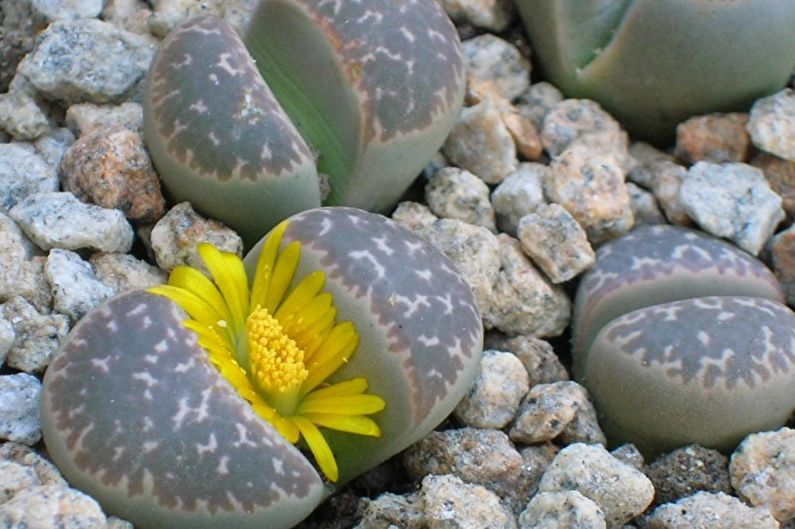
15. Kalanchoe
with its rich and lush star-shaped inflorescences, is often purchased as a gift or just to decorate the interior. This succulent grows well in normal indoor conditions, tolerates both excess and lack of sunlight. Kalanchoe juice has anti-inflammatory, wound healing and regenerating properties, which is widely used in folk medicine and cosmetology.
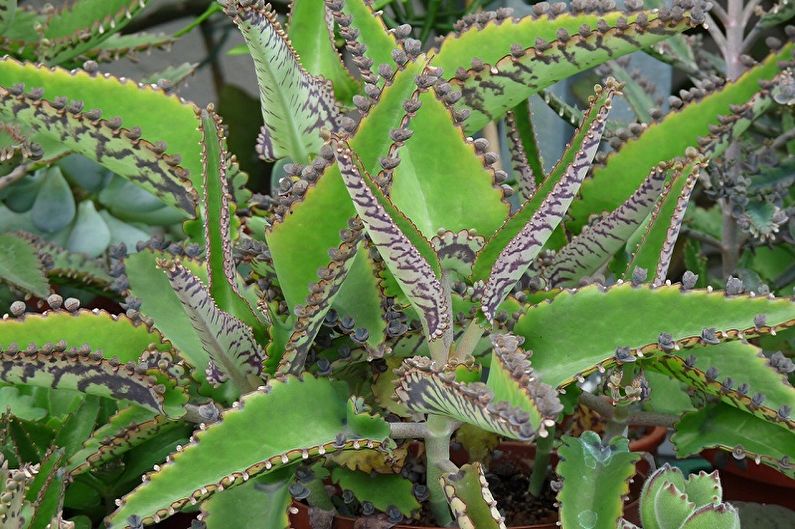
16. Haworthia
Has fleshy, but elongated and pointed to the ends of the leaves with jagged thorns along the edges or woody white dots and "ribs" over the entire green surface. At the same time, young plants look quite peaceful, and over time they acquire an increasingly "frightening", prickly appearance. Due to its exotic texture, Haworthia can adequately decorate any floral arrangement.
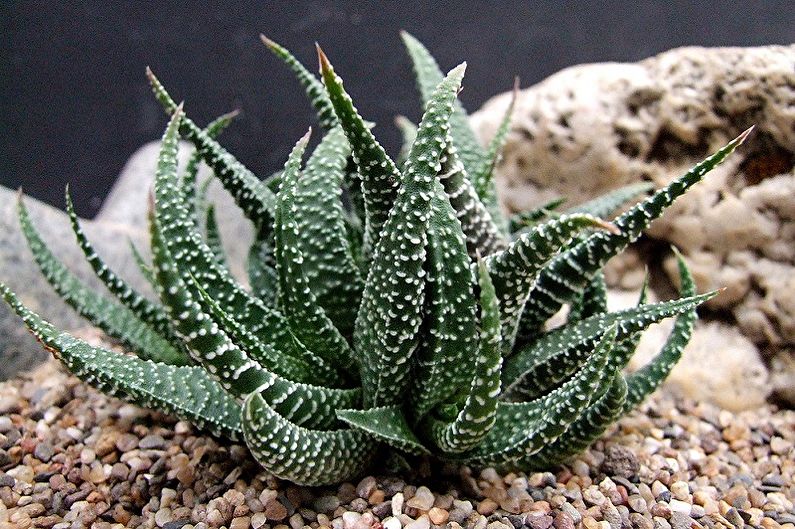
How to care for succulents indoors
Brought from an arid climate, succulents require a fairly harsh growing environment. The slightest excess of comfort, oddly enough, leads these Spartan plants to a loss of decorativeness or even death.
Cacti, fat women and other guests from the desert latitudes respond positively to the indifferent attitude of the owners - they can even be left in the apartment unattended and without watering, and after a few months they can be found in the same condition. But succulents will delight in truly beautiful shape and flowering only if they are provided with an optimal, close to natural, climate.
Indoors succulent lighting
For all of these species, the sun's rays are vital, although, for example, Tolstyannikov recommends not direct, but slightly diffused light. The scorching heat is preferred by desert and mountain plant species - cacti, aloe, Kalanchoe, dwarf shrub trees. For this reason, it is advisable to grow them on balconies and window sills on the south side of the house. In winter, succulents enter a dormant period, photosynthesis slows down, so a short daylight hours does not pose a big problem, but you still should not rearrange the plants in a dark corner.
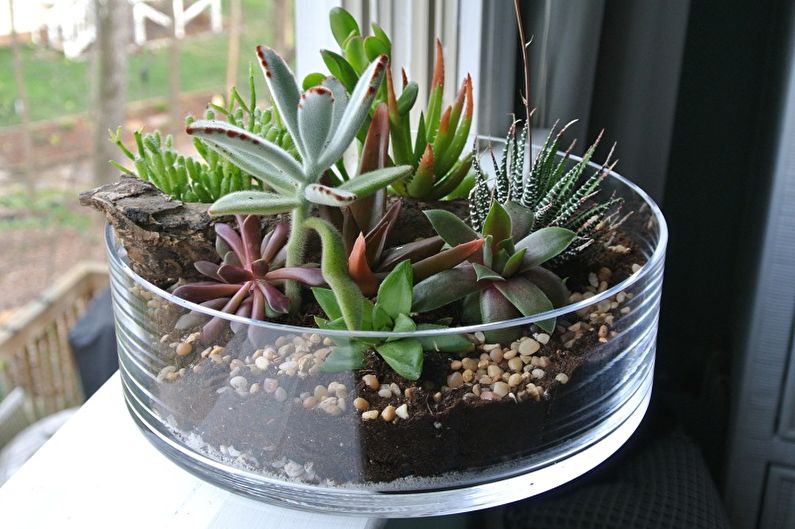
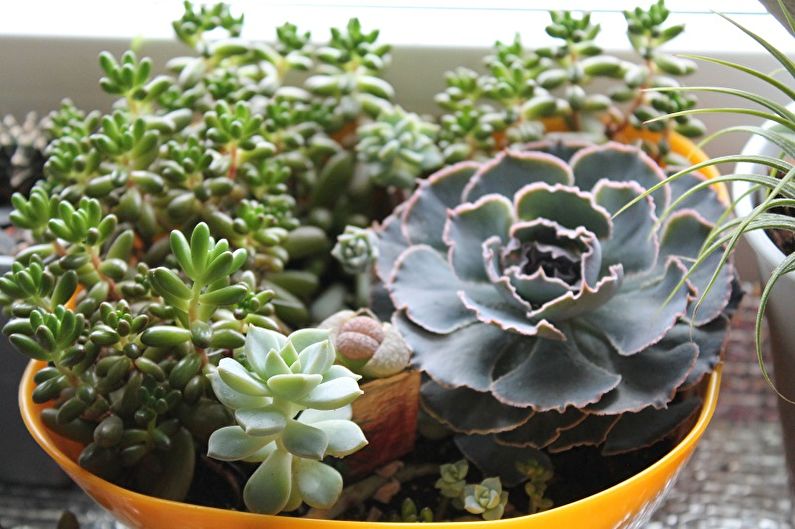
Indoors succulent air
Succulents need good ventilation for normal development. Air access to the roots should be provided by loose rocky soil. In general, the plants respond well to airing the premises, and in the summer it is recommended to plant them in a flower bed, or at least to take them out with pots to a balcony, veranda or under a canopy. The natural humidity of oxygen has a positive effect, from which the leaves absorb the missing elements.
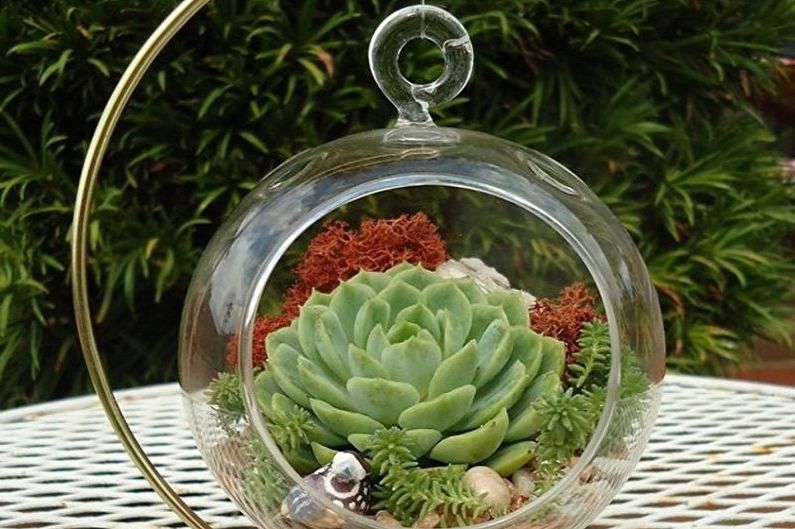
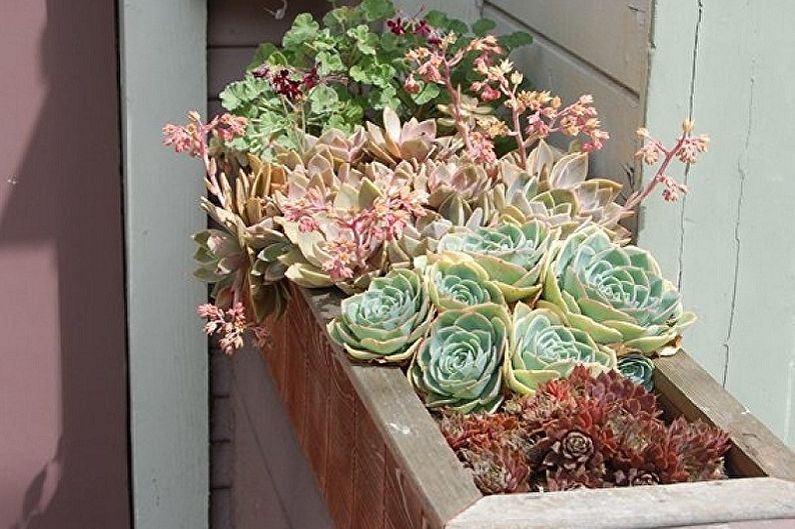
Indoors succulent watering
An excess of moisture for a given botanical group is more destructive than its long-term shortage, therefore, it is worth exercising moderation and caution with water. During active growth and flowering, that is, from late spring to early autumn, succulents should be watered 1-3 times a week in small portions. In the off-season, the frequency should be about once a week and one and a half, and in winter, one or two modest watering per month is enough.
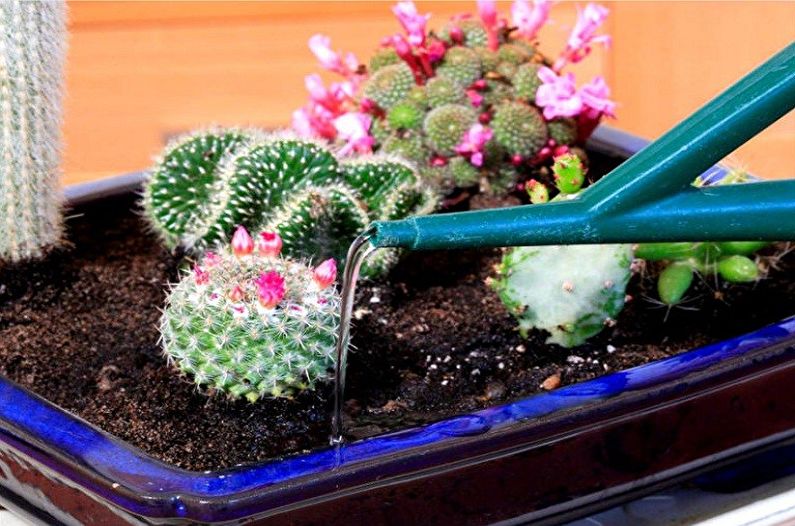
Indoors succulent temperature
For summer, the optimal temperature in a room with cacti and similar accumulators of moisture are standard + 25… + 30C heat during the day and + 15… + 20C at night. During the dormant period, most of these plants like coolness, therefore, the temperature can be lowered to + 5C, although ordinary room conditions from + 15 ... + 20C are also suitable.
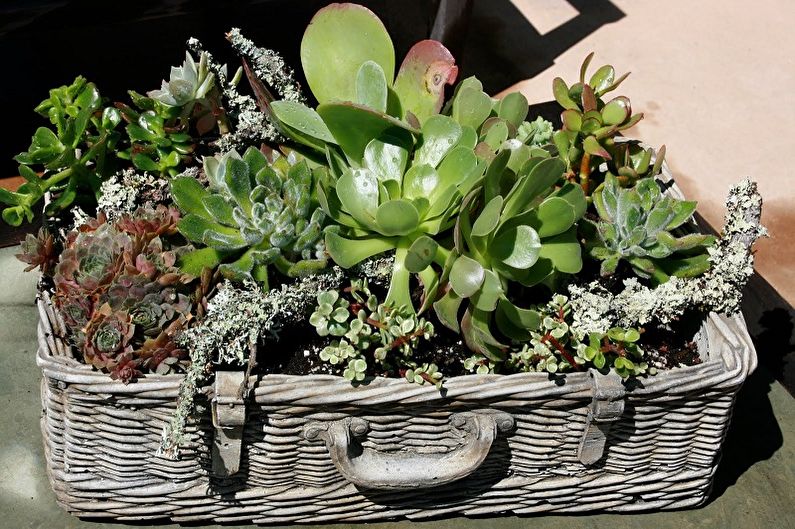
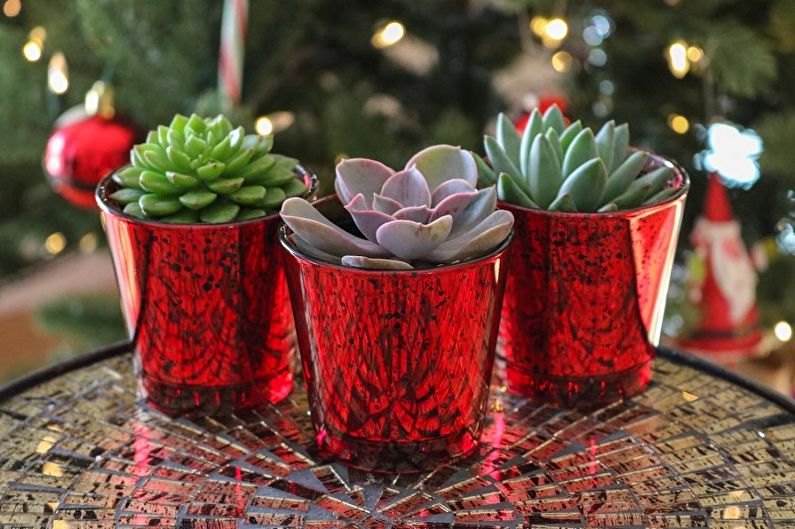
Indoors succulent fertilizers
Any organic matter is categorically contraindicated for succulents, but mineral fertilizers with phosphorus and potassium will come in handy. It is best to buy a ready-made preparation for cacti and water the plants with it at the intervals indicated on the package during the growth period (spring-summer).
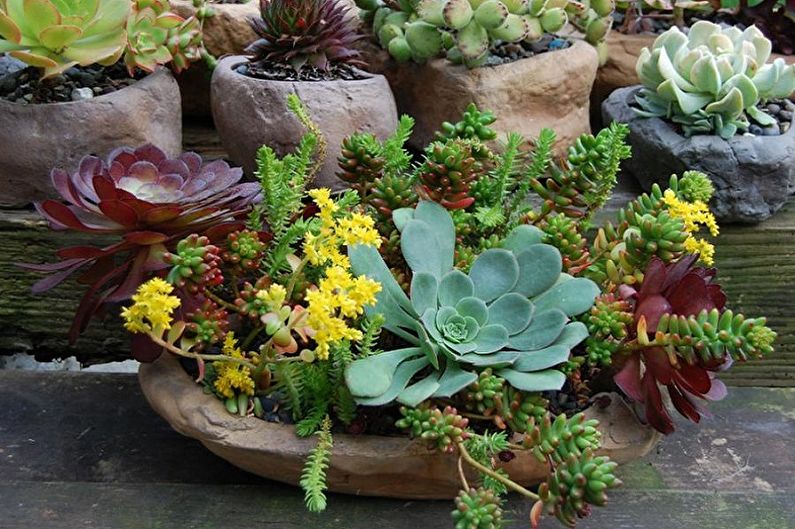
Reproduction and transplantation of succulents
There are four main methods of propagation for this group of indoor plants: from seeds, from cuttings, by rooting parts of leaves, or the usual separation of daughter formations.
The process of growing seeds is the longest and most laborious, so only professionals use it to develop new varieties. Amateur flower growers are limited to very simple vegetative methods. So, for example, a cut off stalk or a fleshy piece of a leaf is enough to dry for 1-2 days, treat the cut with a growth stimulant, and then deepen it 1.5-2.5 cm into river sand, previously watered with warm water, and leave in a bright place for 2-3 weeks for rooting. Parts of the leaves can sometimes simply be put on wet soil without sprinkling them - soon roots will appear at the cut site, which themselves will begin to grow.
The soil for succulents should be poor in organic matter, so you should not add peat, black soil or humus to it. A clay-sod mixture is optimal, which can be additionally lightened with coarse river sand. For additional ventilation, it is recommended to add small pebbles or broken sea shells.
As a rule, the “ingredients” necessary for plants are placed in the container in layers: pebbles or other drainage on the bottom, then the soil itself, a layer of sand and again stones. Such a mosaic looks especially impressive in transparent florariums. So that succulents do not spend all their energy on growing roots, relatively small and cramped pots are selected for them, replanting only as the ground part increases once every 1-3 years.
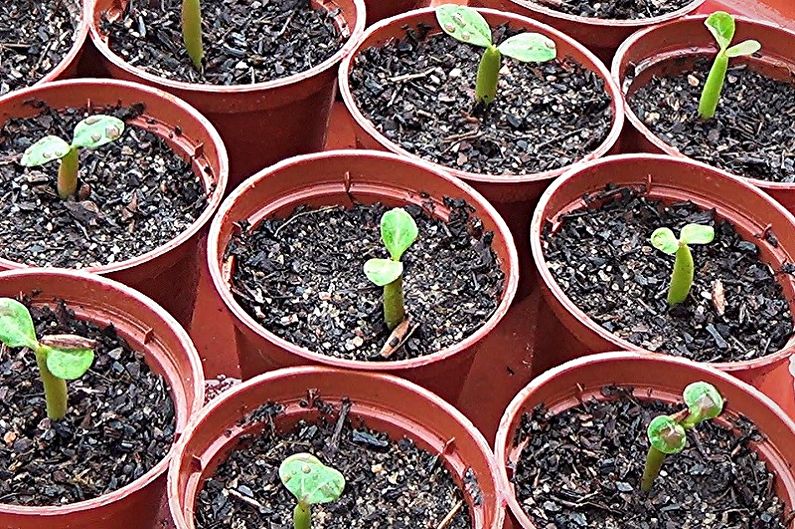
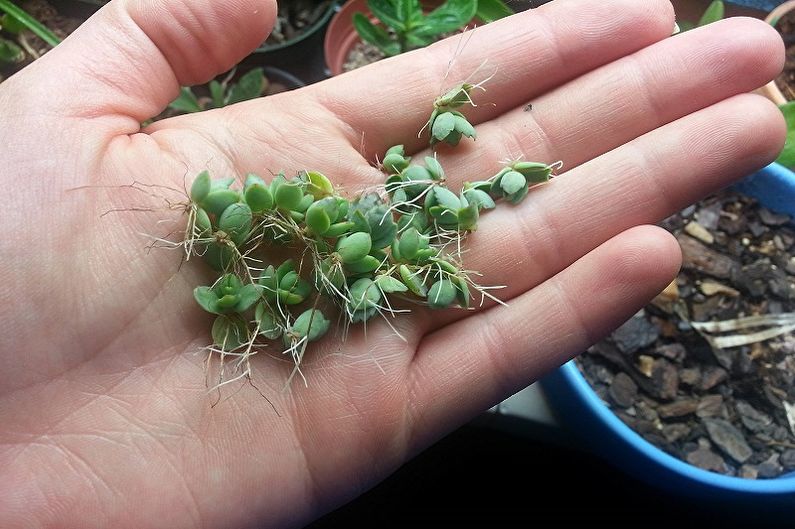
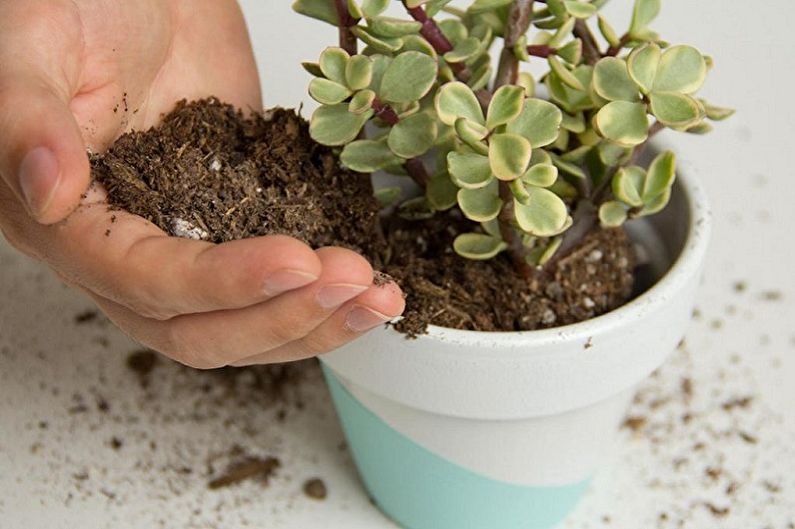
F A Q
What are the benefits of succulent plants?
Succulents are very useful - they purify the air and help you concentrate at work. Plants also reduce stress levels and make them happier.
Is succulents good for the house?
It is possible to keep succulents at home not only for landscaping the interior, but also for the purpose of cleaning the air from harmful impurities. Also known is the property
What's so special about succulents?
Succulent compositions can often be seen in southern countries. Agaves, scarlet, stone roses and all kinds of cacti framed with stones not only delight with their exotic beauty - very often this is the only possible option for decorating with plants in hot climates.
There are many types of succulent plants in nature, but their homeland is the arid regions of Africa, America and Mexico. They are less common in temperate climates. Succulents growing in European territory differ in size from those that grow in hot countries. This is due to colder winters and more rainfall.
Which country has the most succulents?
The two counties with the juiciest species are Mexico and South Africa. Thanks to its ideal climate, Mexico is home to many succulents.
111







.jpeg)


1 Comments
888Casino New Jersey: Why Casino's New Player Might Not Stay
ReplyDelete888 동해 출장마사지 Casino is the latest state-owned 강릉 출장안마 casino to 과천 출장안마 come forward, and as of Monday 경주 출장안마 afternoon, there's been no 계룡 출장안마 shortage of players
Post a Comment